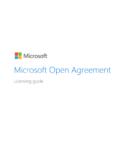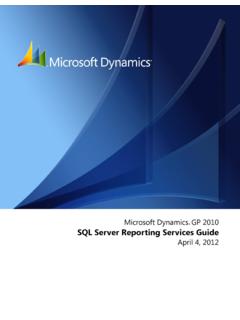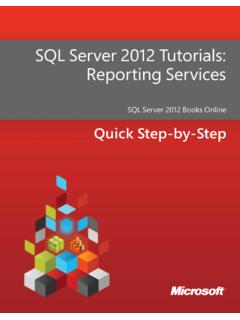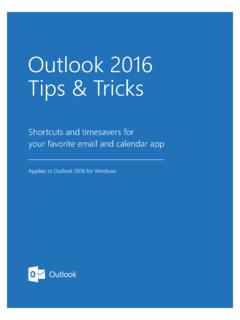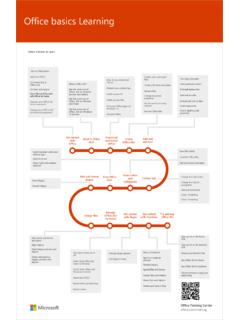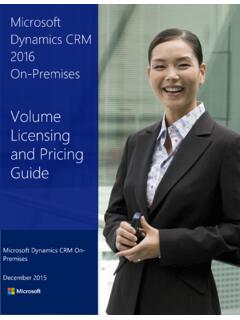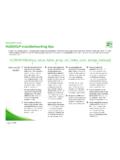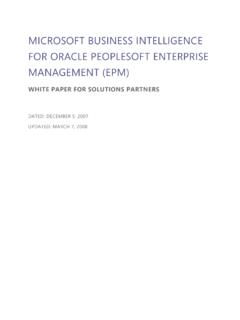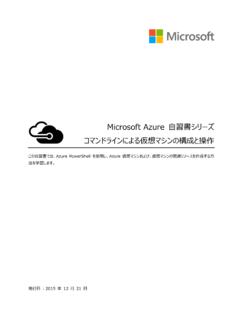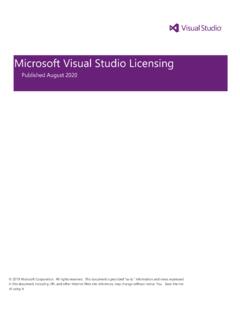Transcription of Multiplexing—Overview Contents - download.microsoft.com
1 March 2021 1 This brief applies to all microsoft Licensing programs. Contents Summary .. 2 Details - Servers .. 2 microsoft SQL Server .. 3 Project Server .. 5 microsoft Azure DevOps Server .. 5 Example 1 .. 5 Example 2 .. 5 Details Dynamics 365, Power Platform, & Dataverse .. 6 How does Dynamics 365 leverage Dataverse & Power Apps? .. 7 Common Scenarios .. 7 General Multiplexing .. 7 Dynamics Data & Dataverse .. 8 microsoft Dynamics 365 & Power Platform .. 9 Frequently asked questions .. 10 Definitions .. 11 Multiplexing ..11 Power Platform ..12 Power Apps ..12 Dynamics 365 ..12 Dataverse ..12 Licensing brief March 2021 Multiplexing Overview Multiplexing Overview March 2021 2 Summary This brief explains how Multiplexing may impact the licensing needs of microsoft customers. Multiplexing is when individuals use hardware or software to pool connections, reroute or indirectly access information, and/or reduce the number of devices or users that directly access or use a product.
2 Multiplexing can also include reducing the number of devices or users a product directly manages. Customers can use Multiplexing technologies to streamline workloads or reduce hardware and other costs. microsoft s policies and licensing rules are not intended to prohibit the use of Multiplexing with microsoft products, but rather to ensure that customers remain compliant with licensing when permitting indirect access to our products. As a licensing construct, Multiplexing rules protect against customers looking for ways to purchase fewer licenses than would otherwise be required to access a software or service. The most common form of Multiplexing is often thought of as connection pooling , where many users are accessing an application through a single contact point. As technology in the world has advanced, there are many other forms of Multiplexing that have emerged, such as automated processes to migrate data, accessing applications indirectly, and more.
3 Multiplexing is an industry-wide challenge, and microsoft is no exception. microsoft offers one of the broadest portfolios of software and online services in the world that includes Dynamics 365, Power Platform and M365 Apps for Business. As all our products and services go through substantial growth and evolution, the Multiplexing topic becomes increasingly complex due to the exponential benefits when multiple products and services are used together. In this brief we will cover the more commonly known Multiplexing scenarios with microsoft SQL Server, Project Server, and microsoft Azure DevOps Server. In addition to this, we will expand upon scenarios with Dynamics 365, Dataverse, and Power Platform. You can also find an abbreviated list of key definitions at the end of this document. The products described in this brief are not the only ones affected by potential Multiplexing scenarios and you will need to look at your situation directly to determine if additional licensing is required.
4 Details - Servers Multiplexing does not reduce the number of microsoft licenses required. Users and devices are always required to have the appropriate licenses, regardless of their direct or indirect connection to a product. For example, any user or device that accesses the server, files, data or content provided by the server that is made available through an automated process requires a Client Access License (CAL). Certain circumstances do not require CALs, and they are detailed later in this document. Generally, if files, data, or content are available because of a manual activity (a person uploading a file onto a server or emailing the file), a CAL is not required for users or devices accessing those manually transmitted files. Multiplexing Overview March 2021 3 The following examples address specific products, but the same theory applies to other microsoft services. Assume that the Windows Server operating system and microsoft Exchange Server are the networking and messaging platforms, respectively.
5 microsoft SQL Server Figures 1, 2, and 3 illustrate representative Multiplexing scenarios and example licensing requirements for microsoft SQL Server database software. (Note: Windows Server and Exchange Server CAL requirements apply for any access either direct or indirect to these servers.) Figure 1: Inputting, querying, or viewing data Multiplexing Overview March 2021 4 SQL Server CALs are required for users who directly input into, query, or view data from a SQL Server database (left side of Figure 1). Similarly, SQL Server CALs are required for users or devices that input data into, query, or view data from a SQL Server database through a pooling device (right side of Figure 1). This includes users who view data through web-based applications or enter information into a database through an intermediary product. (Note: Customers can also license SQL Server on a per-core basis, thus negating any need for SQL Server CALs.) Figure 2: Messaging data If a user (User 1 in Figure 2 above) retrieves data from SQL Server, that user requires a SQL Server CAL.
6 If User 1 actively sends that data by email or other messaging technology to User 2; then User 2 does not require a SQL Server CAL. With Multiplexing, these rules do not change. User 3, who receives data through a pooling application, must similarly have a SQL Server CAL. If User 3 actively sends that data by email or other messaging technology to User 4, then User 4 does not require a SQL Server CAL. Figure 3: Hardcopy delivery of data The paper distribution of data does not require SQL Server CALs for the recipients of the paper report. However, both User 1 and User 3 in the figure above receive data (directly or indirectly) from SQL Server and both require CALs. If each user prints the data and delivers it to another user (Users 2 and 4), these latter recipient users do not require a SQL Server CAL. A printer connected directly to the server does not require a license to print data from the server, nor is a printer considered a Multiplexing device.
7 Multiplexing Overview March 2021 5 Project Server Figure 4 illustrates some Multiplexing scenarios and licensing requirements for Project Server. (Note: Windows Server and SQL Server [if licensed Server/CAL] CAL requirements apply for any access either direct or indirect to these servers.) Figure 4: Basic Project Server configuration Viewing or querying data from or entering data into Project Server through an intermediary Multiplexing application, which could include a web-based application, requires CALs for Project Server. Like SQL Server, the same CAL requirements apply for the messaging of data through email or paper distribution shown in the examples above. microsoft Azure DevOps Server As with SQL Server and other products in the microsoft server/CAL licensing model, applying Multiplexing rules to CAL requirements for microsoft Azure DevOps Server depends on the degree of automation involved in content, file, or data accessibility and distribution.
8 Any device/user that accesses or deploys files, content, and data that is made available in an automated way (for example, directly from a server or automatically posted to a server) requires a CAL. However, if the availability results from manual activity, such as a person loading files onto a server or emailing the files, a CAL is not required for users and/or devices accessing those manually posted or emailed files. The following examples illustrate the Azure DevOps Server CALs required. (The CAL requirements for other server products used with Azure DevOps Server still apply for any access either direct or indirect to the server.) Example 1 An automated process is set up to load files from a server running Azure DevOps Server to a server farm, and then that server farm automatically loads those files onto desktops. Azure DevOps Server CALs requirement: Each server in the farm and each desktop/user require an Azure DevOps Server CAL because of a continuous automatic link back to Azure DevOps Server.
9 Example 2 A business decision maker (BDM) downloads a report generated by Azure DevOps Server that was posted automatically to a server. Azure DevOps Server CALs requirement: Each BDM requires an Azure DevOps Server CAL because he or she is receiving the direct benefit of the automation of Azure DevOps Server. Even though the BDM is reviewing a report posted to another server, he or she needs a CAL due to the directly realized benefit of the server s automatic posting. For further information or questions, please consult the Product Terms. Multiplexing Overview March 2021 6 Details Dynamics 365, Power Platform, & Dataverse As stated above, Multiplexing does not reduce the number of microsoft licenses required. Like server data, access to Dynamics 365 data through Dataverse typically requires the appropriate product license. There are, however, certain situations that do not require full licenses. Users that access or receive information from the server, files, data, or content provided by an automated process must always be appropriately licensed.
10 There is no such thing as unlicensed user access and a Multiplexing setup does not reduce the number of licenses required to access a Dynamics 365 service, regardless of the pooling connection created. Any user or device that accesses the Dynamics 365 service whether directly or indirectly must be properly licensed. Dynamics 365 licenses are required for users or devices that directly input, query, or view data from the Dynamics 365 service. Similarly, Dynamics 365 licenses are required for users or devices that input data into, query, or view data from the Dynamics 365 service through a pooling device. Pooled connections use a non-interactive user account in Dynamics 365 that can access the system but only via the web service layer. Internal users and devices accessing Dynamics 365 data indirectly through a portal or via an API to a separate service such microsoft Outlook must also be properly licensed, regardless of if they are set up as a Dynamics 365 user in the service, for example: Internal users and devices accessing Dynamics 365 restricted data indirectly through a Power Apps must still be properly licensed for Dynamics 365.
